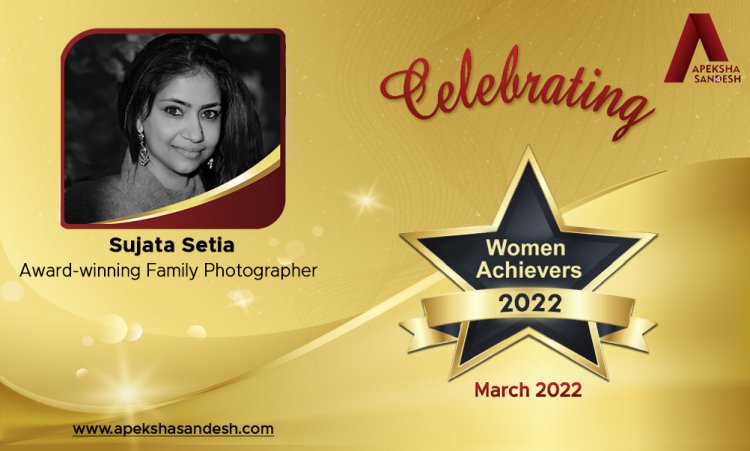We still don’t get paid equally for the same amount or perhaps more work we do in many industries, including mine - Sujata Setia, Multi-award-winning Family Photographer

Sujata Setia is a multi-award winning and published storytelling photographer based in the UK who is known to have set countless trends in the photography world with her images and unique visual language. She is also the first ever child photographer of Indian descent to represent the country in global summits such as the Click Family Conference in Brazil, BabyF in Spain, Congreso Smile in Argentina, Baby & Kid Romania and Portugal to name a few. Her works are often compared with Normal Rokwell’s illustrations, and it is believed that if you are looking at them right now, you might confuse them to be paintings!
Born and brought up in India, Sujata is well-known across the world for being the first photographer to bring babies and furry animals into a single frame to create remarkably heartwarming images. And her “Generations” series capturing the undying love between elderly couples and that of grandparents and grandchildren has gone viral globally.
Sujata has travelled globally to more than 20 countries to teach photography to over 3000+ students, enthusiasts, and professionals alike, and continues to educate and contribute to the collective growth of this industry.
She is the professor of photography at EFTI, one of Europe’s premier photography institutes, based in Spain. She has also served as the jury for many international photography awards. Her most recent series “Changing the Conversation” has won her many international awards, notable amongst that being “Photographer of the Year” at Tokyo International Foto Awards and Winner of the Portrait Award and India’s most prestigious photography festival - Indian Photo Fest. Her works have been published in Forbes, Huffington Post, CNN, The Daily Mail, ABC NEWS, New York Post, CTV NEWS, RTL TV, TIMES NOW, THE HINDU, MUMBAI MIRROR, Buzzfeed, Vanity Fair and Good Housekeeping Magazine, to name a few.
As an artist, Sujata takes the everyday, the ordinary and creates something magical with it. The assurance with which a new mother holds her first born, the tenderness that permeates a long relationship, the carefree way in which a child interacts with nature – her photographs evoke an instant response and connection in the viewer.
Team of Apeksha Sandesh had an interaction with the world-known photographer, Sujata Setia. Heck of the excerpts of the conversation.
How did you started you career in photography?
Photography came into my life at a very timely segue. I was battling clinical depression when photography became my anchor and a way for me to find my voice again - a way for me to communicate with the world and to look within.
You belong to Indian descent. How long did you stay in India and when did you shift to UK?
I am born and brought up in India. I left the country only when I was 27 years old.
What is the biggest challenge you have faced in your career so far, due to being a woman?
Several. But the biggest and the most pressing challenge was that of my own conditioning. I grew up, conditioned to believe that the role of a woman in the society is marriage and motherhood. That a woman’s identity is drawn out of belonging to someone else or some other relationship. And that conditioning held me back for a very long time from carving my own path.
Photography is a niche dominated by males. Tell us about your journey so far in creating a space for yourself and achieving success.
It has been a journey of unlearning and relearning for me. I had to unlearn the belief that all genders aren’t equal. I had to then learn to look at my work as an entity on its own and not something that is attached to my gender. It is not a woman’s work. It is a piece of work and art is gender neutral. There is a difference and I had to first internalize that. Once, I was able to separate my gender identity from my work, I was able to let it do the talking for itself. Yet, to break into a primarily male-dominated industry has not been easy and it is a continuous process of rigour!
I have to be my biggest evangelist. I have to continuously promote my work. There is not a moment when you can stop and take a break and feel like the wheels are churning and results will flow. No, that does not happen ever when you are a woman in an industry dominated by men.
Today every mobile device has camera, rather hi-tech ones, which has led every other person become a photographer. How do you think your industry has affected with this technology advancement? Also, what do you do to overcome this situation and ensure business growth and continuity?
Beautiful question and let me tell you it is a constant struggle. It is not easy. But having said that, the more challenged you are as an artist, the finer your art becomes. That is the beauty of this profession. Challenges only ignite the passion further. Because everyone I meet these days tells me they are a photographer, I am even more encouraged to carve a niche for myself that separates me from everyone else. So, when a client is looking for someone to hire, they know what they would get from me is what only I can create and no one else can do that. And that helps in keeping the continuity in my business. Constantly reinventing myself and making my work relevant with the changing times and technology. It keeps you on your toes!
Your works are often compared with Normal Rokwell’s illustrations, and it is said that one might confuse them to be paintings. How do you achieve that kind of creativity and perfection?
To be honestly, art can never be perfect. It is so deeply subjective that everyone looks at it from their own personal prism. I am grateful for the love and appreciation I have received over time for my work, but I think it is what it is because of the person I am, the way I feel and engage with my immediate surroundings and the world around me and that is what reflects in my work. There are a lot of techniques including lens, camera, light, styling, composition, and of course editing involved in creating the final piece, but the emotion and the story in every image always trumps every other technical aspect.
Tell us more about your series “Changing the Conversation” that has won many international accolades. The ideology behind it, and the work behind it?
I started this personal series “Changing the Conversation” during the pandemic. I lost my mother a little before covid struck. Up until then, photography was my way of recreating the magic of childhood through visual narratives. However, after losing my mother, it felt like I lost my voice and that I had nothing more to say. It took me an entire year of internal dialogue to find my visual language.
With this project I am not only honouring the free spirit of my mother despite her growing up amidst a society deeply influenced by patriarchy and binary stereotypes, but I am also taking the help of art here to reimagine humanity and move beyond the footprints of a world where “majority” is synonymous with “normal.” This series has truly transformed me as a person. It has made me unlearn and relearn the very basic tenets of life… boundaries; biases; perceptions. I have met the most incredible people as part of this project. People who are redefining this world with their courage and acceptance… not only of themselves (for being different) but also of others and how others perceive them. People like Catrin, who is a 96% burn survivor and an empathetic, yet courageous evangelist of normalizing physical differences. Every shoot has been special though. Even if I tried, I won’t be able to express all that I have learnt and experienced through this project.
What is your opinion on (gender) equality? How important the issue is in the current times?
It is a very important conversation. Equality not only for gender but equality as the basic foundation of our lives is paramount. It is like breathing. It is a given for us to live. It should be a given!!
I have an 8-year-old daughter. She has such an inquisitive mind. She comes home to ask me questions like why is a girl who likes to dress up like boys called a “tom boy”? Why aren’t boys who like to dress up like girls called “tom girl”? And why is there a haircut style called “boy cut” but not a haircut style called “girl cut”? These are such foundational questioned that we never think of. How can you gender define clothing and haircuts? We must move beyond these binaries, or the world will forever be at war!
What are your strengths as a woman? And how do they help you in achieving success in your field?
Being a woman is pure strength. I think deeper. I feel more. I express freely. I share whole heartedly. I fall and I stand and then I run, and I fall again and stand again and run fast and keep doing that over and over again, and yet I never shy of making those mistakes and continue to learn from them. I am forever growing and allowing myself that unabashed freedom to learn and grow because the way a woman can feel freedom, the absolute freedom of thought, expression and of all other kinds - that is something only a woman can do. And that is our superpower.
What main change would you like to see for young girls in the next generation?
I want young girls to not feel the bondage of conditioning. I want them to have the freedom to be inclusive and foster an inclusive world as well.
Are there any assumptions about women that you would like to change? Why?
Well, there are many! We still don’t get paid equally for the same amount or perhaps more work we do in many industries, including mine. I would want this assumption to change that women are weaker, and especially weaker once they become mothers.
If you could give one piece of advice to your younger self, what would that be?
I think my younger self would do better giving advice to my older self. When I was young, I was fearless, and I was deeply idealistic. I wish my younger self could come and remind me yet again that the unwavering hope for ‘perfect utopia’ is a great starting point for making the world a better place.
Do you think Women’s Day should be celebrated? Why?
I think every day is Women’s Day, but I am happy that there is a special day and month kept to celebrate us. On a very practical level, I see a lot of push is given during the month of March to create initiatives that are directed to women specifically and a lot of good comes off these initiatives. While they should be in place not just for a month but as a constant occurrence, I feel, until that time comes, we should keep celebrating the 8th of March as our day.
Apeksha Sandesh congratulates Sujata Setia for her contribution and commitment towards the field of photography. We wish her good luck for the future endeavours!















































